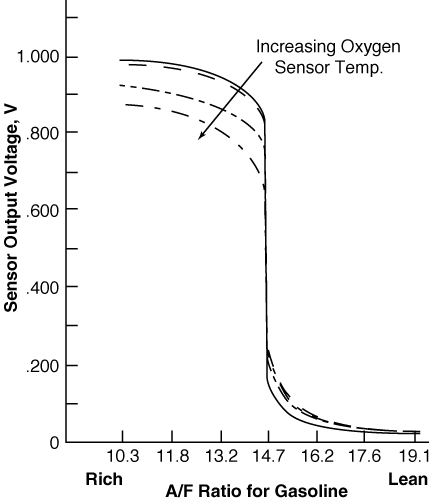AutoMeter A/F RATIO METER & OXYGEN SENSOR OPERATION
|
The A/F Ratio Meter is a voltmeter with a range of 0 to 1
Volt. The meter displays the output voltage of the vehicles
oxygen sensor through 20 LED's. The first LED will come on at a
voltage of .050V, the second at .100V, the third at .150V, etc.
LEAN RANGE:
|
Four red LED's
|
(.050 to .249V)
|
STOICHIOMETRIC RANGE:
|
Ten yellow LED's
|
(.250 to .749V)
|
RICH RANGE:
|
Six green LED's
|
(.750 to 1.000V)
|
The stoichiometric (STOICH) air/fuel ratio is the chemically
correct ratio, theoretically all of the oxygen and all of the
fuel are consumed. The mixture is neither rich nor lean.
However, due to the fact that combustion is never perfect in the
real world, there will always be a small amount of oxygen left
in the exhaust. This small amount that is left is what the
oxygen sensor measures. The smaller the amount of oxygen that is
left in the exhaust, the richer the A/F ratio is, and the higher
the oxygen sensor voltage is. The on-board computer or
Powertrain Control Module (PCM) monitors the voltage from the
oxygen sensor. If the PCM sees an oxygen sensor voltage greater
than .450V, it immediately starts to reduce the amount of fuel
that is metered into the engine by reducing the on time to the
fuel injectors. When this happens, the A/F ratio starts to go in
the lean direction, and the oxygen sensor voltage starts to go
down. When the voltage drops below .450V, the PCM immediately
starts to increase the fuel metered to the engine by increasing
the on time to the fuel injectors to produce a richer A/F ratio.
This occurs until the oxygen sensor voltage goes above .450V.
This repeating cycle happens very fast (many times per second).
The PCM is said to be in closed loop. It is constantly
monitoring the oxygen sensor voltage and adjusting the on time
of the fuel injectors to maintain a stoichiometric A/F ratio.
This A/F ratio produces the lowest harmful exhaust emissions,
and allows the catalytic converter to operate at peak
efficiency, therefore reducing the exhaust emissions further.
Since the oxygen sensor output is non-liner and very
sensitive at the stoichiometric A/F ratio it will cause the A/F
meter LED's to bounce back and forth rapidly. A very small
change in A/F ratio causes a large change in oxygen sensor
voltage as can be seen on the graph. This causes the A/F ratio
meter LED's to rapidly cycle back and forth, and is normal
operation when the PCM is in closed loop and trying to maintain
a stoichiometric A/F ratio.

The oxygen sensor is very accurate at indicating a
stoichiometric A/F ratio. It is also very accurate at indicating
an A/F ratio that is richer or leaner than stoichiometric.
However it can not indicate what exactly the A/F ratio is in the
rich and lean areas due to the fact that the oxygen sensor
output changes with the oxygen sensor temperature and wear. As
the sensor temperature increases, the voltage output will
decrease for a given A/F ratio in the rich area, and increase in
the lean area as shown on the graph.
During wide open throttle (throttle opening greater than 80%
as indicated by the throttle position sensor) the A/F ratio will
be forced rich by the PCM for maximum power. During this time
the oxygen sensor outputs a voltage that corresponds to a rich
A/F ratio. But the PCM ignores the oxygen sensor signal because
it is not accurate for indicating exactly what the A/F ratio is
in this range. The PCM is now in open loop, and relies on
factory programmed maps to calculate what the on time of the
fuel injectors should be to provide a rich A/F ratio for maximum
power. The A/F ratio meter should indicate rich during this
time.
During hard deceleration the PCM will command an extremely
lean mixture for lowest exhaust emissions. This may cause the
A/F ratio meter not to indicate anything. The A/F ratio is so
lean that it is outside the range that the meter will indicate.
|
|
|